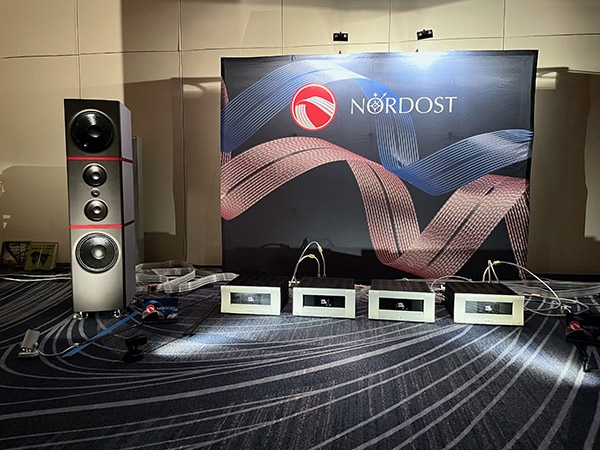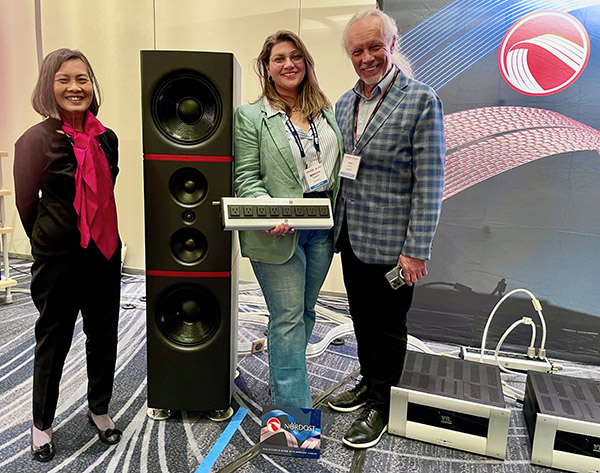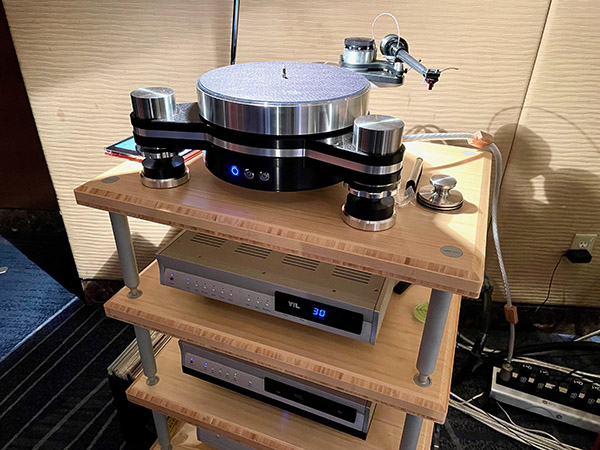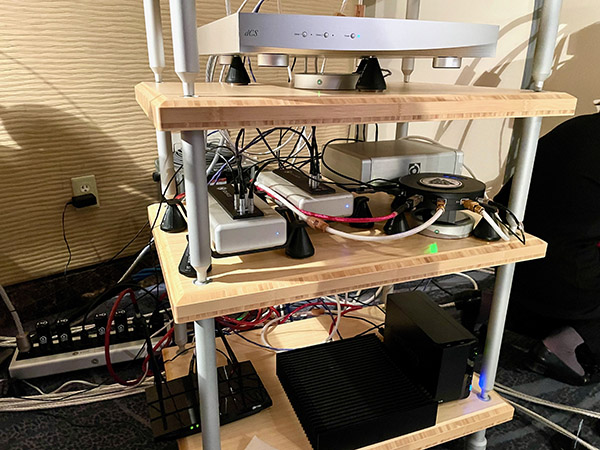| Columns Retired Columns & Blogs |
Jason, I don’t think you mentioned the brand of the rack in the last photo. Do you know what it is? Very nice looking…

The system included one premiere: the Nordost QBase Mark III, aka QB8 Mk III ($2300). This eight-outlet passive distribution block uses star-ground topology to address, in Nordost's words, "the noise-inducing, conflicting flows of signal and ground paths." Given that I use the 20-amp Mark II for most of my digital front end, I'm excited to discover the differences wrought by a newly designed dual-pcb configuration, increased separation of ground connections, minimized interference/crosstalk, enhanced trace sizes, and a revised resistance "sink" intended to add protection and better damp eddy current. While it was impossible to tell what all these changes made to the sound of this system, it should be fairly easy to discern any differences in my own reference system.
How to describe the system's impact? First, my attention was drawn to the natural and real sound of bass. On the 32/352.8 MQA track of Patricia Barber's "This Town" from Clique, I heard the largest, most timbrally correct, believable, and luscious presentation of a double bass I may have ever heard from a sound system. On top of that, the smallest change in Barber's voice, including the emotional shift at the end, as well as every instrumental overtone and nuance was audible. Listening to this track was as satisfying as the finest meal I've ever eaten. And I had no need to shout over people at the next table in order to commune in silence with everyone around me.

Next, VTL's Bea Lam (left in photo, with Meredith Gabor of Nordost, center, and Michael Marko of Nordost, right) turned to LP, and Cécile McLorin Salvant's "Le mal de vivre." I sat at this artist's feet (literally) when she performed at New York's Blue Note last fall, but she sounded equally close to me here. The warmth of her voice was marvelous and the control absolute. I didn't even bother to take notes when Nat King Cole began to sing "The Very Thought of You." Instead, I put down my pen, closed my notebook and eyes, and blissed out.

This was an anything but inexpensive system. Start with the Stenheim Reference Ultime Two loudspeakers ($155,000/pair). Then add VTL's TP-6.5 Series II Signature phono stage ($15,000), TL-7.5 Series III Reference Line Preamplifier($35,000), two MB-450 Series III Signature monoblocks ($30,000/pair) on the Stenheim's midrange and tweeter, and two MB-185 Series III Signature monoblocks ($27,000/pair) on the bass, and you're on to the dCS Rossini Apex DAC ($32,800) and Rossini Master Clock ($10,850). Next, from VPI came the Avenger Direct turntable ($36,000) with Lyra Etna cartridge ($8995).

As this photo shows, then there was more Nordost cabling and accoutrements than I dared add up. That includes a wheelbarrow-full of Odin 2 cabling plus Valhalla 2 Ethernet cables, an Odin 2 tonearm cable ($16,700), a QNet network switch with QNet stand, QSource linear power supply with premium and DC cables, QPOINT resonance synchronizers, QKore ground units and premium wires, Sort supports, and more.
Yes, the system cost a lot. A very big lot. But it sounded like heaven.

That is the Sort Rack which we made specifically for our use at trade shows. It uses Nordost's Sort System technology to drain unwanted vibration from the rack and always gives us plenty of room to use our full suite of QRT and Sort products!

Hi Jason,
While there is actually a 32-bit/352.8kHz DXD version of this album available for download, that has absolutely nothing to do with anything MQA.
There is no 32-bit MQA version of this album, there is only a pseudo 16-bit MQA-CD version of this album that is then upsampled to 352.8kHz, but in any case that wouldn't be the 32-bit original DXD, just an upsampled MQA-CD version which is actually not even 16-bit resolution, more like 14-15-bit with the aforementioned upsampling using a leaky minimum phase digital filter that is prone to aliasing.
Maybe what you heard in that room was actually the original master 32-bit/352.8kHz DXD download and not MQA at all?

Somehow I thought my version was MQA. I see I've confused it with the MQA-encoded DXD files provided to me by Morten Lindberg of 2L. Thanks for pointing this out.
I have promotional 32/352.8 WAV files of this album, provided by Jim Anderson. Ditto for Higher.

I have the Higher SACD and that too is really great, but for Clique! I just bought the 32/352.8 DXD from NativeDSD.com as that is the actual master recording.
Now those 2L files you have are also not DXD if they are MQA encoded. All MQA files are by default either 44.1 or 48kHz sample rate, period... hard stop.
The higher sample rates displayed on any given DAC using MQA encoded files only occur as a result of upsampling. That doesn't at all mean you aren't allowed to like how those 2L provided files sound, just simply that the native sample rates of MQA encoded tracks are by definition not DXD, they can only be 44.1 or 48kHz.
Nice show report BTW.

From Morten Lindberg:
"Our recordings are DXD and the resolution is preserved all thru the process, including the variant distributed thru the MQA container. Our approach is totally transparent allowing for people to choose the raw DXD or MQA in our shop, compare and make up their own mind :-)"
From me. Yesterday, I sat in my music room with a manufacturer I'm reviewing. We played some of his favorite tracks and, in one case, compared MQA (Tidal) and non-MQA (Qobuz) versions of an older track that was either recorded or mastered in 16/44.1. We both preferred the MQA version.
Opinions will differ, of course. I have nothing more to say about this. Anyone or everyone who wants to pile on and disagree, or who wants to proclaim that MQA is dead and drag the body through the streets is free do to so. But you won't be dragging me along. I'll be too busy enjoying the music.

I wasn't interested in any argument with you or anyone else, and since I don't have any 2L recordings I wouldn't actually know how they offer their deliverables to the public, so I too will stand corrected just as you did. I said in my 2nd post you are of course allowed to like what you like from a sonic perspective and I stand by that, even if the technical merits (or lack thereof) of MQA very much call that into question.

I recently purchased the QBASE MK III . I owned the previous QBASE MKII . In my setup the new MKIII is a significant leap forward in performance over the MKII . Well done Nordost !